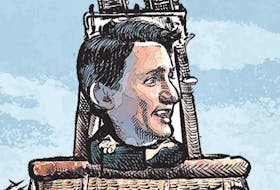The most remarkable recent trend in Canadian politics has been the rise of the Greens. Since the last election, the party had been locked in at its usual six per cent in the polls, give or take a half a percentage point — until this year, when it suddenly began to take off. Recent polls put it at 11 or 12 points, within spitting distance of the NDP.

The newfound public interest in the Greens has translated into multiple seats in several provincial elections — British Columbia in 2017, New Brunswick in 2018, P.E.I. in 2019 — as well as the recent federal byelection in Nanaimo-Ladysmith, adding to the impression of momentum.
Much of the party’s gains would appear to be at the expense of the Liberals, reflecting increasing public disenchantment with the prime minister, personally, as well as with the Liberals’ handling of energy and environmental issues. But it is no less significant that left-leaning voters, as they peel away from the Grits, are looking past the NDP, in favour of their more absolutist rivals.
The same trend is observable elsewhere, as climate change increasingly displaces the old politics of class and even the new politics of identity as the driving issue on the left. The Greens were among the major winners in the recent European Union elections — with 69 seats, they are now the fourth-largest bloc in the European Parliament — while candidates for the Democratic presidential nomination compete to outdo each other with the radicalism of their environmental plans.
Inevitably, something of the same bidding war has erupted on the left in this country. Feeling the heat from the Greens, last week the NDP unveiled a $15-billion plan to subsidize the greenification of virtually everything that moves (100 per cent electric buses on city streets by 2030, every new car a zero-emission vehicle by 2040) or doesn’t (every new building energy efficient by 2030, every existing building by 2050).
All told, the New Democrats think their plan could cut Canada’s greenhouse gas emissions by 38 per cent from 2005 levels by 2030, significantly exceeding the federal target of a 30 per cent reduction — though not without using “the powers of the federal government” to force similar targets on the provinces. That should be fun.
Small beer, say the Greens, who had earlier unveiled their own 20-point climate action plan. Calling climate change “the gravest security threat the world has ever seen,” it calls for emissions to be reduced by fully 60 per cent by 2030, with a further target of zero emissions by 2050.
To achieve this, it calls for the creation of an all-party “war cabinet,” which would impose such measures as a ban on fracking, an end to foreign oil imports, and the replacement of all internal-combustion vehicles (not just new ones) with electric by 2040.
To put this in context, all of the existing federal and provincial programs combined had succeeded in reducing Canada’s emissions, as of 2017, by just two per cent from their 2005 levels, according to the most recent Environment Canada accounting. The department reckons we are on track to reduce those by another 14 percentage points by 2030.
But the NDP thinks its proposals will be enough, in the space of a decade, to cut emissions by another 22 percentage points beyond that, while the Greens claim the ability to cut them by another 22 percentage points beyond what the NDP can achieve. Whether this can be done at all may be fairly doubted; whether it can be done at an acceptable cost to the economy even more so. But for voters in the NDP-Green universe, this is now what is required.
Which leaves the Liberals in something of a quandary. At about 31 per cent in the polls, they are roughly four points behind the Conservatives. Are the votes they need — the votes they have lately lost — to be found among those currently backing the Conservatives? Or are they to be found among the roughly similar sized pool of voters supporting the parties to their left?
Until now the Liberals had been occupying the centre ground in the climate debate, attempting to balance the competing demands of the economy — specifically, the energy sector — and the environment. Where the Conservatives were against carbon pricing, and the Greens and (some of) the NDP against building pipelines, the Liberals were for both.
Should the Liberals be tempted to move further left, however, they risk ceding that middle ground to the Conservatives. Until lately that would have seemed unlikely. The Conservatives have not only opposed carbon pricing, but have resolutely refused to offer any emissions reduction plan of their own.
In the meantime, however, the ground has been shifting. Public support for carbon pricing has proved soft; pro-carbon pricing governments in several provinces have been replaced by Conservatives implacably opposed. Some prominent environmental economists have lately called for abandoning carbon pricing, in favour of more politically feasible, if more economically costly, regulatory approaches.
Which means that by the time Andrew Scheer unveils his plan, as heavy on regulation as it is expected to be, it is conceivable it might get a respectful hearing. No, it won’t get us to 30 per cent, but neither would the Liberal plan, as currently drafted. For most of the voters the two parties are contending for, it will be enough that he has a plan.
And if the Liberals, fearing further erosion of support to their left, go further? Then Scheer can claim that it is he, and not Justin Trudeau, who has struck the better balance between the environment and the economy.
Are his policies inferior, his targets inadequate? Almost certainly. It does not matter. In politics, victory goes not to the party with the better program, but the better story.
Copyright Postmedia Network Inc., 2019









